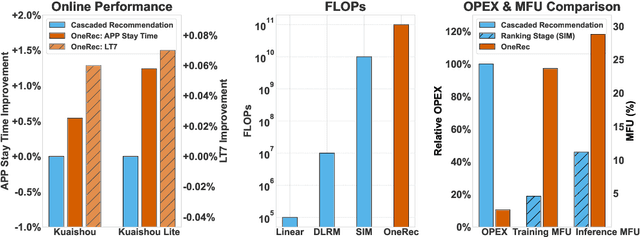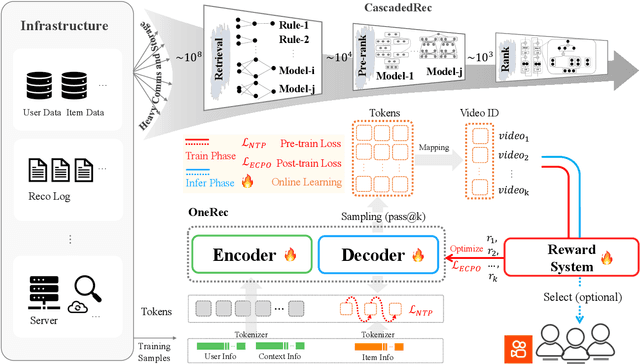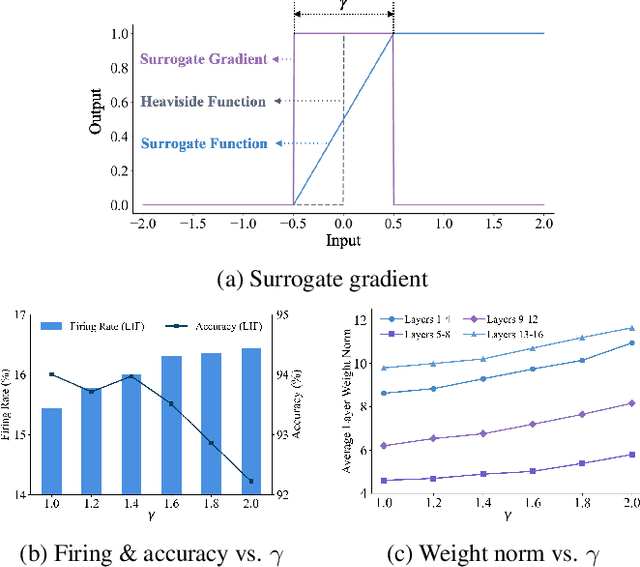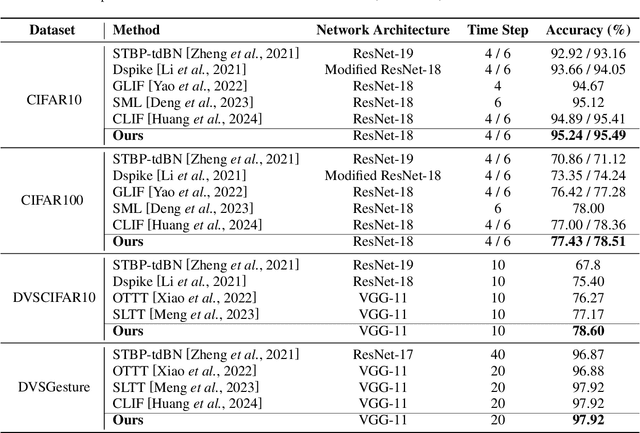Bin Zhang
CogniSNN: Enabling Neuron-Expandability, Pathway-Reusability, and Dynamic-Configurability with Random Graph Architectures in Spiking Neural Networks
Dec 12, 2025Abstract:Spiking neural networks (SNNs), regarded as the third generation of artificial neural networks, are expected to bridge the gap between artificial intelligence and computational neuroscience. However, most mainstream SNN research directly adopts the rigid, chain-like hierarchical architecture of traditional artificial neural networks (ANNs), ignoring key structural characteristics of the brain. Biological neurons are stochastically interconnected, forming complex neural pathways that exhibit Neuron-Expandability, Pathway-Reusability, and Dynamic-Configurability. In this paper, we introduce a new SNN paradigm, named Cognition-aware SNN (CogniSNN), by incorporating Random Graph Architecture (RGA). Furthermore, we address the issues of network degradation and dimensional mismatch in deep pathways by introducing an improved pure spiking residual mechanism alongside an adaptive pooling strategy. Then, we design a Key Pathway-based Learning without Forgetting (KP-LwF) approach, which selectively reuses critical neural pathways while retaining historical knowledge, enabling efficient multi-task transfer. Finally, we propose a Dynamic Growth Learning (DGL) algorithm that allows neurons and synapses to grow dynamically along the internal temporal dimension. Extensive experiments demonstrate that CogniSNN achieves performance comparable to, or even surpassing, current state-of-the-art SNNs on neuromorphic datasets and Tiny-ImageNet. The Pathway-Reusability enhances the network's continuous learning capability across different scenarios, while the dynamic growth algorithm improves robustness against interference and mitigates the fixed-timestep constraints during neuromorphic chip deployment. This work demonstrates the potential of SNNs with random graph structures in advancing brain-inspired intelligence and lays the foundation for their practical application on neuromorphic hardware.
DAP: A Discrete-token Autoregressive Planner for Autonomous Driving
Nov 17, 2025Abstract:Gaining sustainable performance improvement with scaling data and model budget remains a pivotal yet unresolved challenge in autonomous driving. While autoregressive models exhibited promising data-scaling efficiency in planning tasks, predicting ego trajectories alone suffers sparse supervision and weakly constrains how scene evolution should shape ego motion. Therefore, we introduce DAP, a discrete-token autoregressive planner that jointly forecasts BEV semantics and ego trajectories, thereby enforcing comprehensive representation learning and allowing predicted dynamics to directly condition ego motion. In addition, we incorporate a reinforcement-learning-based fine-tuning, which preserves supervised behavior cloning priors while injecting reward-guided improvements. Despite a compact 160M parameter budget, DAP achieves state-of-the-art performance on open-loop metrics and delivers competitive closed-loop results on the NAVSIM benchmark. Overall, the fully discrete-token autoregressive formulation operating on both rasterized BEV and ego actions provides a compact yet scalable planning paradigm for autonomous driving.
Prescribed Performance Control of Deformable Object Manipulation in Spatial Latent Space
Oct 16, 2025Abstract:Manipulating three-dimensional (3D) deformable objects presents significant challenges for robotic systems due to their infinite-dimensional state space and complex deformable dynamics. This paper proposes a novel model-free approach for shape control with constraints imposed on key points. Unlike existing methods that rely on feature dimensionality reduction, the proposed controller leverages the coordinates of key points as the feature vector, which are extracted from the deformable object's point cloud using deep learning methods. This approach not only reduces the dimensionality of the feature space but also retains the spatial information of the object. By extracting key points, the manipulation of deformable objects is simplified into a visual servoing problem, where the shape dynamics are described using a deformation Jacobian matrix. To enhance control accuracy, a prescribed performance control method is developed by integrating barrier Lyapunov functions (BLF) to enforce constraints on the key points. The stability of the closed-loop system is rigorously analyzed and verified using the Lyapunov method. Experimental results further demonstrate the effectiveness and robustness of the proposed method.
Phenome-Wide Multi-Omics Integration Uncovers Distinct Archetypes of Human Aging
Oct 14, 2025Abstract:Aging is a highly complex and heterogeneous process that progresses at different rates across individuals, making biological age (BA) a more accurate indicator of physiological decline than chronological age. While previous studies have built aging clocks using single-omics data, they often fail to capture the full molecular complexity of human aging. In this work, we leveraged the Human Phenotype Project, a large-scale cohort of 12,000 adults aged 30--70 years, with extensive longitudinal profiling that includes clinical, behavioral, environmental, and multi-omics datasets -- spanning transcriptomics, lipidomics, metabolomics, and the microbiome. By employing advanced machine learning frameworks capable of modeling nonlinear biological dynamics, we developed and rigorously validated a multi-omics aging clock that robustly predicts diverse health outcomes and future disease risk. Unsupervised clustering of the integrated molecular profiles from multi-omics uncovered distinct biological subtypes of aging, revealing striking heterogeneity in aging trajectories and pinpointing pathway-specific alterations associated with different aging patterns. These findings demonstrate the power of multi-omics integration to decode the molecular landscape of aging and lay the groundwork for personalized healthspan monitoring and precision strategies to prevent age-related diseases.
OneRec-V2 Technical Report
Aug 28, 2025



Abstract:Recent breakthroughs in generative AI have transformed recommender systems through end-to-end generation. OneRec reformulates recommendation as an autoregressive generation task, achieving high Model FLOPs Utilization. While OneRec-V1 has shown significant empirical success in real-world deployment, two critical challenges hinder its scalability and performance: (1) inefficient computational allocation where 97.66% of resources are consumed by sequence encoding rather than generation, and (2) limitations in reinforcement learning relying solely on reward models. To address these challenges, we propose OneRec-V2, featuring: (1) Lazy Decoder-Only Architecture: Eliminates encoder bottlenecks, reducing total computation by 94% and training resources by 90%, enabling successful scaling to 8B parameters. (2) Preference Alignment with Real-World User Interactions: Incorporates Duration-Aware Reward Shaping and Adaptive Ratio Clipping to better align with user preferences using real-world feedback. Extensive A/B tests on Kuaishou demonstrate OneRec-V2's effectiveness, improving App Stay Time by 0.467%/0.741% while balancing multi-objective recommendations. This work advances generative recommendation scalability and alignment with real-world feedback, representing a step forward in the development of end-to-end recommender systems.
OneRec Technical Report
Jun 16, 2025



Abstract:Recommender systems have been widely used in various large-scale user-oriented platforms for many years. However, compared to the rapid developments in the AI community, recommendation systems have not achieved a breakthrough in recent years. For instance, they still rely on a multi-stage cascaded architecture rather than an end-to-end approach, leading to computational fragmentation and optimization inconsistencies, and hindering the effective application of key breakthrough technologies from the AI community in recommendation scenarios. To address these issues, we propose OneRec, which reshapes the recommendation system through an end-to-end generative approach and achieves promising results. Firstly, we have enhanced the computational FLOPs of the current recommendation model by 10 $\times$ and have identified the scaling laws for recommendations within certain boundaries. Secondly, reinforcement learning techniques, previously difficult to apply for optimizing recommendations, show significant potential in this framework. Lastly, through infrastructure optimizations, we have achieved 23.7% and 28.8% Model FLOPs Utilization (MFU) on flagship GPUs during training and inference, respectively, aligning closely with the LLM community. This architecture significantly reduces communication and storage overhead, resulting in operating expense that is only 10.6% of traditional recommendation pipelines. Deployed in Kuaishou/Kuaishou Lite APP, it handles 25% of total queries per second, enhancing overall App Stay Time by 0.54% and 1.24%, respectively. Additionally, we have observed significant increases in metrics such as 7-day Lifetime, which is a crucial indicator of recommendation experience. We also provide practical lessons and insights derived from developing, optimizing, and maintaining a production-scale recommendation system with significant real-world impact.
Graph of Verification: Structured Verification of LLM Reasoning with Directed Acyclic Graphs
Jun 14, 2025



Abstract:Verifying the reliability of complex, multi-step reasoning in Large Language Models (LLMs) remains a fundamental challenge, as existing methods often lack both faithfulness and precision. To address this issue, we propose the Graph of Verification (GoV) framework. GoV offers three key contributions: First, it explicitly models the underlying deductive process as a directed acyclic graph (DAG), whether this structure is implicit or explicitly constructed. Second, it enforces a topological order over the DAG to guide stepwise verification. Third, GoV introduces the notion of customizable node blocks, which flexibly define the verification granularity, from atomic propositions to full paragraphs, while ensuring that all requisite premises derived from the graph are provided as contextual input for each verification unit. We evaluate GoV on the Number Triangle Summation task and the ProcessBench benchmark with varying levels of reasoning complexity. Experimental results show that GoV substantially improves verification accuracy, faithfulness, and error localization when compared to conventional end-to-end verification approaches. Our code and data are available at https://github.com/Frevor/Graph-of-Verification.
MoQAE: Mixed-Precision Quantization for Long-Context LLM Inference via Mixture of Quantization-Aware Experts
Jun 09, 2025Abstract:One of the primary challenges in optimizing large language models (LLMs) for long-context inference lies in the high memory consumption of the Key-Value (KV) cache. Existing approaches, such as quantization, have demonstrated promising results in reducing memory usage. However, current quantization methods cannot take both effectiveness and efficiency into account. In this paper, we propose MoQAE, a novel mixed-precision quantization method via mixture of quantization-aware experts. First, we view different quantization bit-width configurations as experts and use the traditional mixture of experts (MoE) method to select the optimal configuration. To avoid the inefficiency caused by inputting tokens one by one into the router in the traditional MoE method, we input the tokens into the router chunk by chunk. Second, we design a lightweight router-only fine-tuning process to train MoQAE with a comprehensive loss to learn the trade-off between model accuracy and memory usage. Finally, we introduce a routing freezing (RF) and a routing sharing (RS) mechanism to further reduce the inference overhead. Extensive experiments on multiple benchmark datasets demonstrate that our method outperforms state-of-the-art KV cache quantization approaches in both efficiency and effectiveness.
ILIF: Temporal Inhibitory Leaky Integrate-and-Fire Neuron for Overactivation in Spiking Neural Networks
May 15, 2025



Abstract:The Spiking Neural Network (SNN) has drawn increasing attention for its energy-efficient, event-driven processing and biological plausibility. To train SNNs via backpropagation, surrogate gradients are used to approximate the non-differentiable spike function, but they only maintain nonzero derivatives within a narrow range of membrane potentials near the firing threshold, referred to as the surrogate gradient support width gamma. We identify a major challenge, termed the dilemma of gamma: a relatively large gamma leads to overactivation, characterized by excessive neuron firing, which in turn increases energy consumption, whereas a small gamma causes vanishing gradients and weakens temporal dependencies. To address this, we propose a temporal Inhibitory Leaky Integrate-and-Fire (ILIF) neuron model, inspired by biological inhibitory mechanisms. This model incorporates interconnected inhibitory units for membrane potential and current, effectively mitigating overactivation while preserving gradient propagation. Theoretical analysis demonstrates ILIF effectiveness in overcoming the gamma dilemma, and extensive experiments on multiple datasets show that ILIF improves energy efficiency by reducing firing rates, stabilizes training, and enhances accuracy. The code is available at github.com/kaisun1/ILIF.
CogniSNN: A First Exploration to Random Graph Architecture based Spiking Neural Networks with Enhanced Expandability and Neuroplasticity
May 09, 2025



Abstract:Despite advances in spiking neural networks (SNNs) in numerous tasks, their architectures remain highly similar to traditional artificial neural networks (ANNs), restricting their ability to mimic natural connections between biological neurons. This paper develops a new modeling paradigm for SNN with random graph architecture (RGA), termed Cognition-aware SNN (CogniSNN). Furthermore, we improve the expandability and neuroplasticity of CogniSNN by introducing a modified spiking residual neural node (ResNode) to counteract network degradation in deeper graph pathways, as well as a critical path-based algorithm that enables CogniSNN to perform continual learning on new tasks leveraging the features of the data and the RGA learned in the old task. Experiments show that CogniSNN with re-designed ResNode performs outstandingly in neuromorphic datasets with fewer parameters, achieving 95.5% precision in the DVS-Gesture dataset with only 5 timesteps. The critical path-based approach decreases 3% to 5% forgetting while maintaining expected performance in learning new tasks that are similar to or distinct from the old ones. This study showcases the potential of RGA-based SNN and paves a new path for biologically inspired networks based on graph theory.
 Add to Chrome
Add to Chrome Add to Firefox
Add to Firefox Add to Edge
Add to Edge